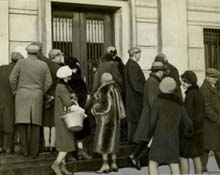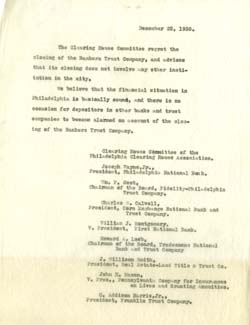We are nearly finished with phase one of the Greenfield Digital Project -- transcribing and adding basic XML encoding to 300+ documents selected from HSP's collections to help tell the story of Bankers Trust Company, the first large bank to fail in Philadelphia during the Great Depression.
|
As we’ve investigated the story of Bankers Trust, we’ve learned about its quick rise and steep fall, how its failure affected 100,000+ depositors, how it became part of a “publishers’ war” between two Philly newspapers, and much more.
One of the last sets of documents we've been transcribing are papers from the Clearing House Association of Philadelphia records (collection 1908). This banking association was officially organized in 1858 to better coordinate daily exchanges between its member banks. Bank presidents in the city had already been meeting regularly for several years to talk shop, but after the serious financial panic of 1857, they decided to adopt the clearing house system begun in New York. Now, member banks were formally connected and staff could meet in one common place to settle daily balances, such as when a customer from one bank deposited a check from another.
Bankers Trust Company was elected to membership in the association in September 1930. But its tenure in the group would be brief.
When Bankers Trust voluntarily turned over its operations to the Pennsylvania Department of Banking on December 22, 1930, the Clearing House Committee of the association issued a public statement intended to calm depositors in other banks. Signed by eight bank presidents, the statement assured, “[w]e believe that the financial situation in Philadelphia is basically sound.”
|
But the situation was perhaps not as secure as the Clearing House Committee hoped.
Franklin Trust Company, one of the eight banks listed on the Clearing House Association statement, faced its own bank run the same day that Bankers Trust closed. Within 10 months, it too was taken over by the state Department of Banking. Altogether, about one-third of Philadelphia’s banks failed between 1930 and 1933.
The Clearing House Association records are open to researchers, as are the Albert M. Greenfield papers (collection 1959), which details much of the Bankers Trust story thanks to Greenfield’s service on the bank’s board of directors.
In a few weeks, we'll turn out attention to annotating our selected documents. We’ll be researching and writing brief histories of the people, businesses, and organizations involved in the rise and fall of Bankers Trust, as well as creating other web content aimed at helping teachers use these primary source documents in the classroom. You can read more about how our work fits into a larger effort funded by the Albert M. Greenfield Foundation here.


